Discover 11 hidden attractions, cool sights, and unusual things to do in Merced (United States). Don't miss out on these must-see attractions: Merced Theatre, Merced County Courthouse Museum, and Merced Multicultural Arts Center - the MAC. Also, be sure to include United States Post Office in your itinerary.
Below, you can find the list of the most amazing places you should visit in Merced (California).
Table of Contents
Merced Theatre
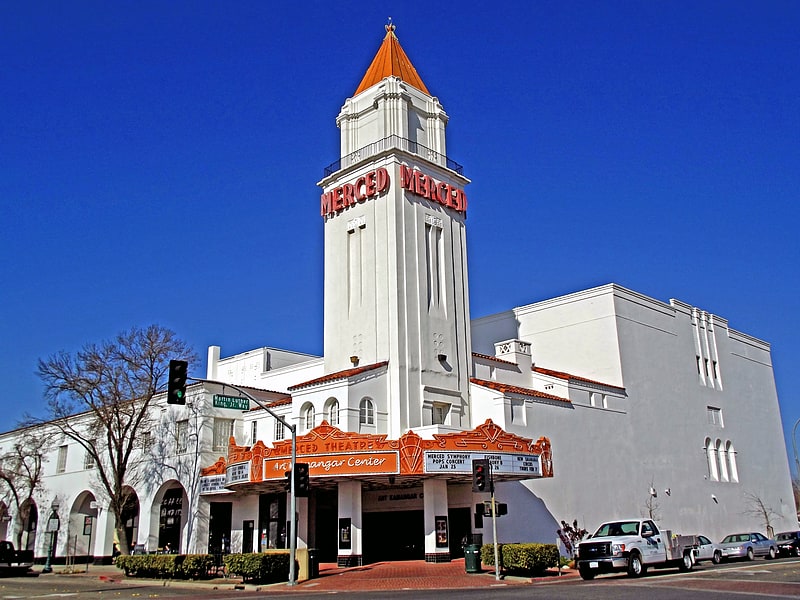
Theatre in Merced, California. The Merced Theatre is located at 301 W. Main Street, at the corner of Main Street and Martin Luther King Way, in Merced, California. The theatre is significant both for its role as the social and cultural center of Merced from the Depression through the post World War II era and for its mix of Art Deco and Spanish Colonial Revival architecture. The property was added to the National Register of Historic Places on May 1, 2009 and the listing was announced as the featured listing in the National Park Service's weekly list of June 5, 2009.
The Golden State Theatre Company hired San Francisco architects the Reid Brothers to design the Merced Theatre. Another notable building they designed is the Hotel del Coronado in San Diego, California. They used what was at the time the most modern projection and sound technology, and the theatre was only the second building in Merced to have an air conditioning system. Their use of dramatic atmospheric features included castle facades and ventilators that sent "clouds" floating across the star-bespeckled ceiling.
Builder Gian Battista Pasqualetti used steel from the Golden Gate Iron Works, ornamental iron from the San Jose Iron Works, and ornamental tiles from the Hispano Maresque Tile Company in Los Angeles to construct the Reid Brothers design for the multi-level, white stucco coated steel framed reinforced concrete building. A 100-foot high tower rises above the marquee, and the orange neon block letters proclaiming MERCED can be seen for miles.
The lobby includes a mural of Spanish exploration done by Dutch-born artist Antoon Bonaventure Heinsbergen. Original furnishings include Spanish style wooden sofas and chairs. The theatre originally seated 1,645 for filmed and live performances. For a time the Merced Theatre was part of the United Artist chain of theatres. In the early 1980s the theatre was divided into 4 sections cutting off the entire balcony section from the main theater and splitting both. Over time the theater has suffered some wear and tear, but received a full restoration near to its original single full stage and screen design and currently has a full season of touring shows and films.[1]
Address: 301 W Main St, 95340-4819 Merced
Merced County Courthouse Museum
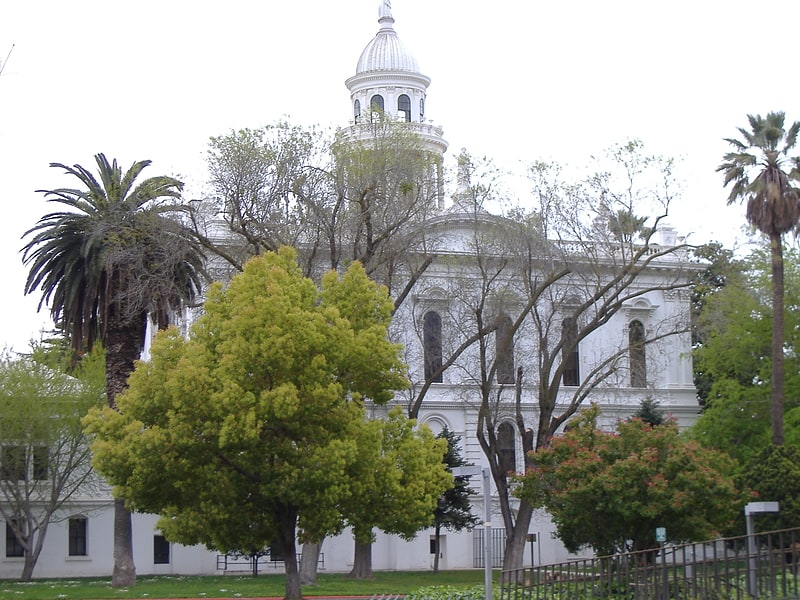
Museum in Merced, California. The Merced County Courthouse is the historic county courthouse in Merced County, California. Located at the intersection of W. 21st and N Streets in Merced, the building served as Merced County's courthouse from 1875 until 1975. A. A. Bennett, an architect who also worked on the California State Capitol, designed the building. The building's Italian Renaissance design was styled to resemble a palazzo; it features a white plaster exterior, a portico with a balcony on the south side, and a cupola atop the roof. A nearly identical courthouse was built in Fresno County at the same time; this building was modified extensively and later demolished, leaving the Merced County Courthouse as the only remaining example of its design. The building's architecture is unique within the southern Central Valley; in its National Register nomination, the courthouse was called "the best example of the Italian Renaissance revival remaining between Sacramento and Los Angeles".
The building is now a museum of local history known as the Merced County Courthouse Museum that is operated by the Merced County Historical Society. Exhibits include the Superior Courtroom, a historic schoolroom and blacksmith shop.
The Merced County Courthouse was added to the National Register of Historic Places on October 29, 1975.[2]
Address: 21st & N Streets, Merced
Merced Multicultural Arts Center - the MAC
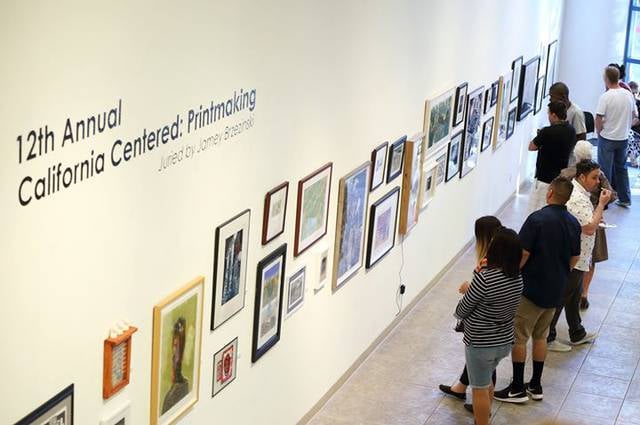
Art gallery, Shopping, Museum
Address: 645 W Main St, 95340-4717 Merced
United States Post Office
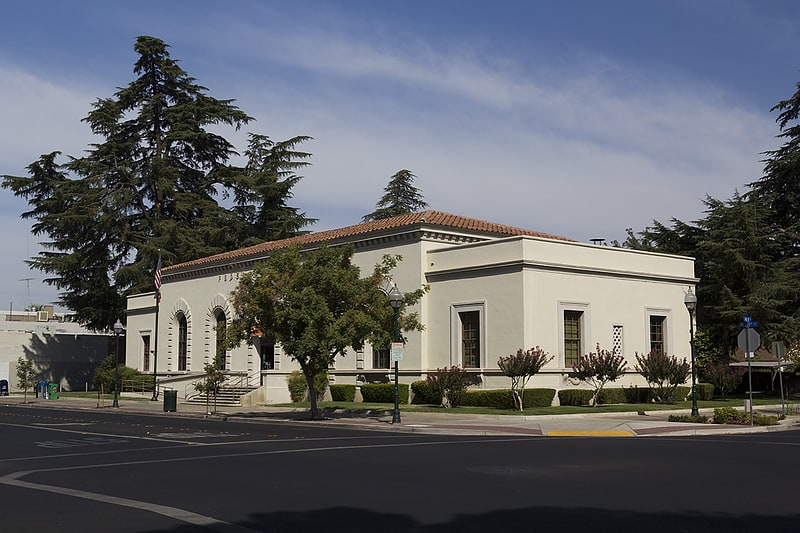
Post office in Merced, California. The U.S. Post Office, also known as the Federal Building, is a post office located at 401 W. 18th St. in Merced, California. The post office was built in 1933 as part of a public works program started by Herbert Hoover. The building was designed by Los Angeles architects Allison & Allison in the Mediterranean Revival style; its design includes a tile roof, stucco walls, and arched windows with terra cotta surrounds. The building's use of Mediterranean elements in an unadorned design reflected the notion of "starved classicism" used in many of Hoover's public works projects; this form of design used themes from classical styles in the plain manner of the Art Deco and Moderne styles.[3]
Address: 401 W 18th St, 95340-4803 Merced
The Mainzer
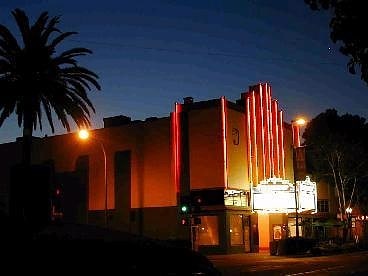
The Mainzer, also known as The Mainzer Theater or The Mainzer-Strand Theater, is a music venue in Merced, California once known for its indie rock scene. It is also recognized by the Art Deco Society of California for the restoring and remodeling process which took place beginning in 1999.[4]
Bank of Italy
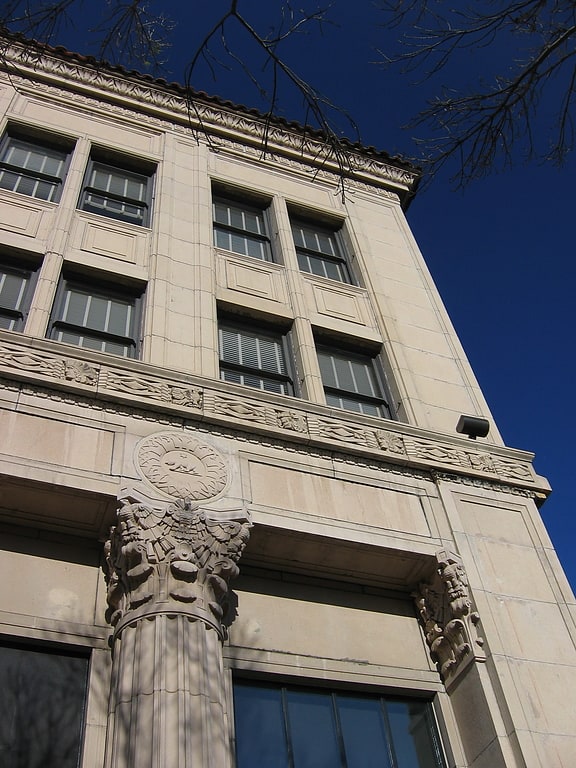
The Bank of Italy is a historic bank building located at the intersection of Main and Canal Streets in Merced, California. Opened in 1928, the bank was Merced's branch of the Bank of Italy. Henry A. Minton designed the building in the Classical Revival style. The bank's design includes a flat, clay tile roof with terra cotta mansards and an ornamental cornice and frieze. Five Corinthian columns are situated on the building's Main Street facade, and seven pilasters face Canal Street. The first and second floors of the bank are separated by a decorative band of panels; the band features alternating square panels displaying an Indian head or an eagle separated by rectangular panels with a diamond design. The building's exterior is mostly faced in Travertine marble; the base is faced in granite, and parts of the first floor were covered with stucco in the 1950s.
The building is known locally as the "Mondo Building." From 2004 through 2019 the building was leased to UC Merced as administrative office space.
In 2019, the building was purchased by the Merced County Office of Education, which currently uses the building as a conference, event, meeting, and office space.[5]
Leggett House
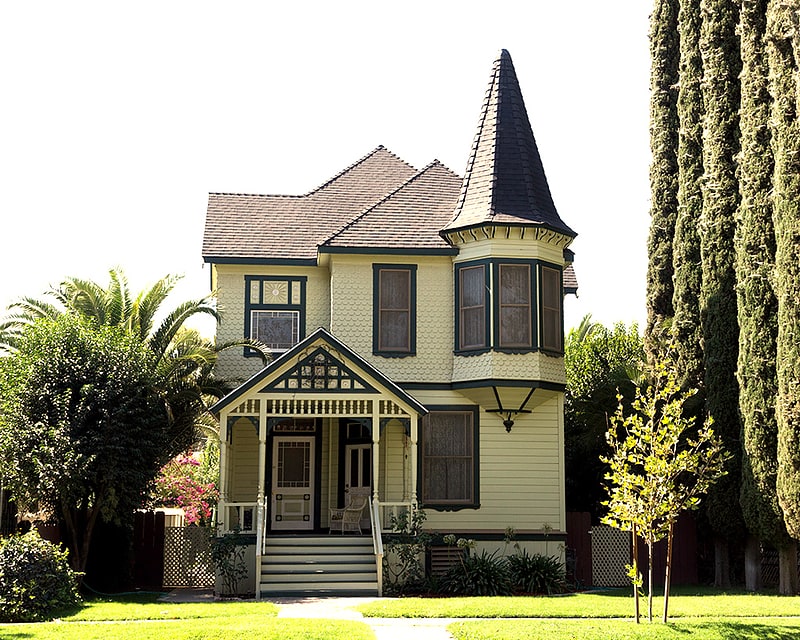
The Leggett House in Merced, California, also known as Queen Anne Inn, is a historic house located at 352 W. 22nd St. in Merced, California. The house was built in the Queen Anne style of Victorian architecture. Its most prominent feature is the Witch's Cap on its roof, a cone-shaped turret with eight scalloped hips. The home's design also includes a steep shingle roof, gables on the porch and sides of the house, and horizontal shiplap and fish scale shingle siding on its first and second floors respectively. E. M. Herron, a local rancher, built the home in 1884; he later sold it to pioneer and Merced postmaster Thomas H. Leggett, who operated a jewelry store in the house's parlor.
The Leggett House was listed on the National Register of Historic Places on October 25, 1979. The Thomas H. Leggett House, another house in Merced owned by Leggett, is also listed on the National Register.[6]
Thomas H. Leggett House
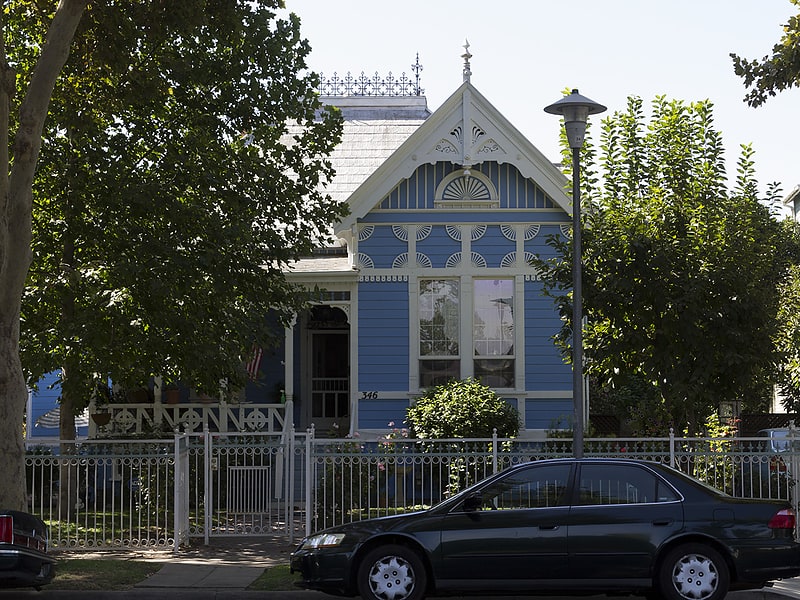
The Thomas H. Leggett House is a historic house located at 346 W. 21st St. in Merced, California. Built circa 1890, the house is designed in the Queen Anne style and also features elements of the Stick and Eastlake style. The front and west sides of the house feature decorative projecting gables; a frieze decorated with quarter sunbursts lies below the gables. The roof is topped by a widow's walk with a decorative iron railing. Thomas H. Leggett, a Merced County law officer and Merced postmaster, built and owned the house.
The Thomas H. Leggett House was added to the National Register of Historic Places on July 8, 1982. The Leggett House, another home in Merced owned by Leggett, is also on the National Register.[7]
Tioga Hotel
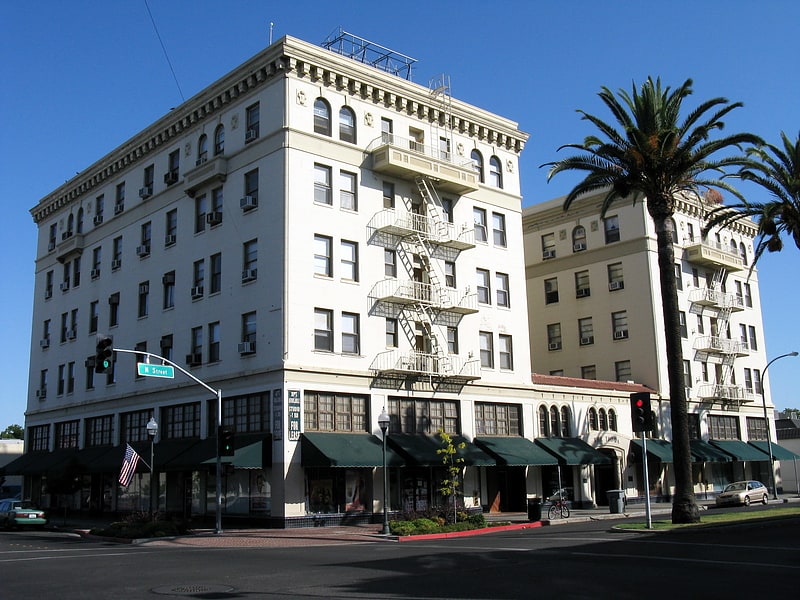
Hotel. The Tioga Hotel is a historic hotel building located at 1715 N St. in Merced, California. Built in 1928, the hotel is the largest building in Merced. The hotel's architecture reflects the transitional design common in 1920s hotels, which were moving away from the Classical Revival designs used in hotels in the past. In addition, the building boasted Merced's first neon sign. The Tioga Hotel was a grand hotel which hosted prominent guests, including Eleanor Roosevelt, Calvin Coolidge, Mary Pickford, and various foreign royalty. During World War II, the hotel played a role in the war effort; the U.S. Air Force used a floor of the building for offices, and various organizations held wartime fundraisers in its lobby and ballrooms. After the war, manager Gyle Miller returned the hotel to its former prominence; in the following decades, the hotel hosted film stars and served as a center for agricultural trade. The rise of automobile travel ultimately led to the hotel's decline, and it was converted to a residential apartment building.
The Tioga Hotel was added to the National Register of Historic Places on October 3, 1980. In 2011, financial discrepancies were discovered resulting in a discovery of an embezzlement operation and the arrest of the property manager, James M. Hiestand. As of 2018, The Tioga has taken on new management, GSF Properties, Inc. in order to bring life back to the community. A $15 million renovation project began that transformed the building back into the hotel it once was. It is now a mission of GSF's to ensure The Tioga's guest feel safe, taken care of, and proud to call The Tioga their home, as well as to bring this historic site back to the eyes of the community, in hopes this massive renovation helps to fuel the major transformation of Downtown Merced and its surrounding communities.[8]
Maj. George Beecher Cook House
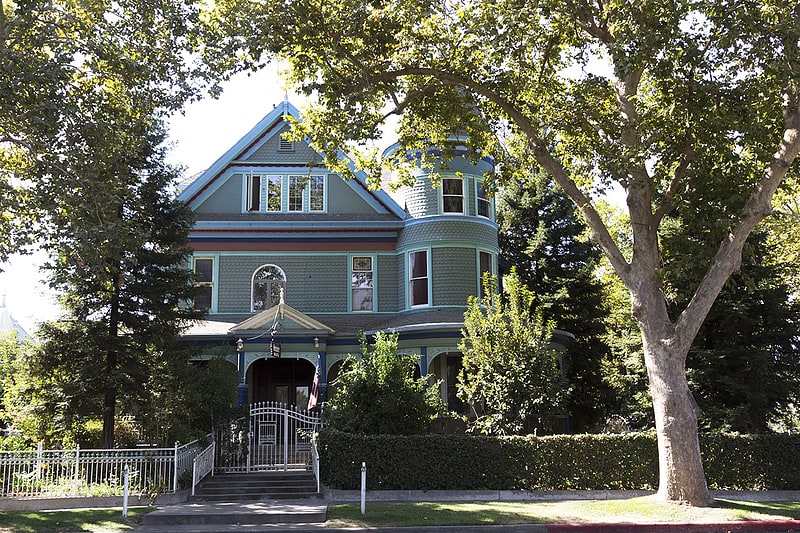
The Maj. George Beecher Cook House is a historic house located at 356 W. 21st St. in Merced, California. Built circa 1887, the house was designed in the Queen Anne style; it is considered one of the best examples of the style in Merced. The house's asymmetrical design features a cylindrical tower, open porches in the front and back, and a 7-sided bay on the west side. The roof of the house includes many different designs; the main roof pattern is a gable roof from the front to the back, but the roof also has a pyramidal section in the center, a cross gable on the east side, hipped dormers, and a cone-shaped roof on the tower. The house uses horizontal siding on its first floor and patterned shingle siding on its upper floors.
Major George Beecher Cook, a mayor of Merced and local merchant, lived in the house until his death in 1898. The house was later used as a sanitarium and boarding house until 1943, when Alfred Green and his wife bought the property. The Greens converted the house to a guest house, which they named "The Greenbrier" for their last name and Mrs. Green's maiden name, Brier.
The Maj. George Beecher Cook House was added to the National Register of Historic Places on September 15, 1983.[9]
Kaehler-Rector House

The Kaehler–Rector House is a historic house located at 408 W. 25th St. in Merced, California. Built in the early 1890s, the house was designed by architect Louis Wegner in the Queen Anne style. The house's design includes a corner tower with a conical roof, a veranda extending to the front and east sides of the house, and a complex roof design that includes both gabled and hipped sections. A 1905 history of the San Joaquin Valley called the house "one of the finest in Merced County."
George Kaehler, the house's first owner, was a major liquor distributor in the San Joaquin Valley. In 1903, he sold the house to Judge E. N. Rector, a Merced County Superior Court judge, who lived in the house until his 1941 death.
The Kaehler–Rector House was added to the National Register of Historic Places on January 4, 1982.[10]